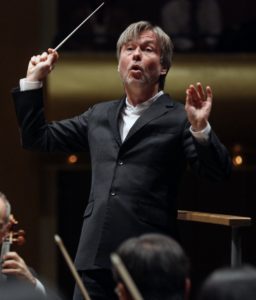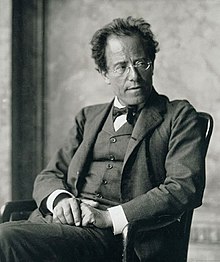June 28, Davies Symphony: The San Francisco Symphony performed Mahler’s Symphony No. 3 in D Minor. It was a stunning presentation. Each movement was full of surprises, emotions, music that inspired our imaginations. San Francisco has been Mahler territory from the beginning of Michael Tilson Thomas’ tenure as Music Director. The Muni had Mahler painted on the sides of buses. MTT brought us great performances. Now, it is Music Director Esa-Pekka Salonen’s time to make the audience marvel at the music and the brilliance of conductor and musicians. This concert was the last of the regular season. It was another great musical experience from the SF Symphony.
 Esa-Pekka Salonen, Music Director, San Francisco Symphony.
Esa-Pekka Salonen, Music Director, San Francisco Symphony.
Before Gustav Mahler began to compose his Symphony No. 3 in D minor, he wrote a scenario in five parts, like sketching the story behind a play. He gave a title to each part. At first, the titles were following this theme: What the Forest Tells Me, What the Trees Tell Me, What Twilight Tells Me, but he changed the titles five times during his summer retreat. He removed the trees, the twilight, and the rest. He switched to Summer entering the symphony, and he wanted to add something Dionysiac, possibly scary. The various images that came to him worked. In less than three weeks he had written the 2nd, 3rd, 4th, and 5th movements. When Symphony No. 3 premiered in 1902, none of the titles were on the program. Mahler wrote to conductor, Josef Krug-Waldsee the reason why he removed them.
“Those titles were an attempt on my part to provide non-musicians with something to hold on to and with a signpost for the intellectual, or better, the expressive content of the various movements and for their relationships to each other and to the whole. That didn’t work (as, in fact it could never work) and that it led only to misinterpretations of the most horrendous sort became painfully clear all too quickly.”*
I was glad to read another quotation from Mahler in a conversation with Sibelius about what a symphony is because I have often thought that Mahler’s symphonies encompassed the world. He said, “a symphony must be like the world. It must embrace everything.”* Symphony No. 3 surely demonstrated that.
The first movement is nearly a half hour on its own. That is because Mahler sees so much. The beginning is joyful but a change comes immediately, something sad, more than sad has been released. We hear what might be funeral music, wailing, anger at the undoing of the human. Then, there are marches which are followed by what could be popular music that plays with a gentle hand that turns to enthusiasm. Yes, it is the whole world. Each of us lives all of the turns of experience which Mahler recalls for the listener and for the listener to re-live right now right here whether in a concert hall or hiking past a small town. This first movement, Part I, Kraftig, entschieden (Powerful, determined) is the full first part giving us moments of danger and loss as well. He does not abandon us to loss but reminds us of love.
Part II includes four briefer movements, each with its own identity. The first one is a minuet: Tempo di menuetto. Sher massig (Moderate). Then, the music is placed out doors with a song by Mahler, Ablusung im Sommer. He awaits “Lady Nightingale’s” song once the cuckoo stops. The trumpet becomes a post-horn with a beautiful tune which is carried by the flutes. Arnold Schoenberg observed, “at first with the divided high violins, then, even more beautiful if possible, with the horns.”* The symphony continues to a song by Nietzsche. It is the Midnight Song from also sprach Zarathustra. This song begins by warning humanity. Then, it explains the depth of eternity. “The world is deep–/deeper than the day had thought!/Deep is the pain!/Joy deeper still than heart’s sorrow!/Pain says: Vanish!/ Yet all joy aspires to eternity,/ to deep, deep eternity.” Soloist Kelley O’Connor, mezzo-soprano, sang the first. Her voice fit well with both songs. Her presence communicates authority and, even as a sinner, attracts empathy.
 Kelley O’Connor, mezzo-soprano
Kelley O’Connor, mezzo-soprano
Next the sopranos and altos of the SF Symphony Chorus plus young boys of the Pacific Boychoir Academy sang the text of The Boy’s Magic Horn (Des Knaben Wunderhorn) with added text by Mahler: “But you mustn’t weep.” The SF Chorus sounded wonderful. O’Connor joined in this song as the sinner. The children made bell sounds and joined the SF Symphony Chorus in “Liebe nur Gott!” Love only God.
Mahler did a daring thing – when did he not do a daring thing? – and ended his symphony with an adagio. The music runs into the terrible, nameless event of the first movement. The interruption of his forward motion leads his music to spiritual directions. The duet of kettle drums was astonishing. The percussionists used drumsticks with large heads of something looking like cotton on the striking end. Side by side the percussionists, each with two drums sticks, struck the drums simultaneously, loudly, and powerfully. Side to side over and over. It created chills, questions, a mystery. The composer instructed the drums should be played “not with brute strength (but) with rich, noble tone” and that “the last measure not be cut off sharply”* in order to produce softness and a silence in the hall and in each listener. Mahler’s No. 3 has the fullness of life. This was Mahler’s world.
*quotations are quoted from the SF Symphony article by Michael Steinberg.
